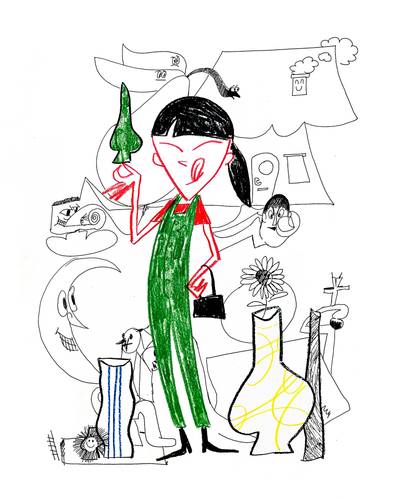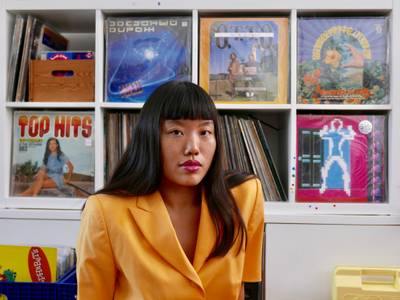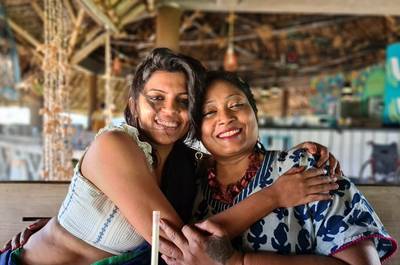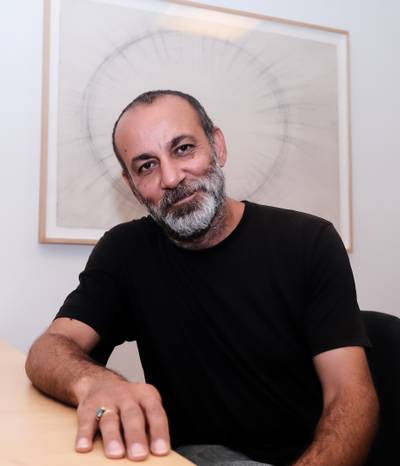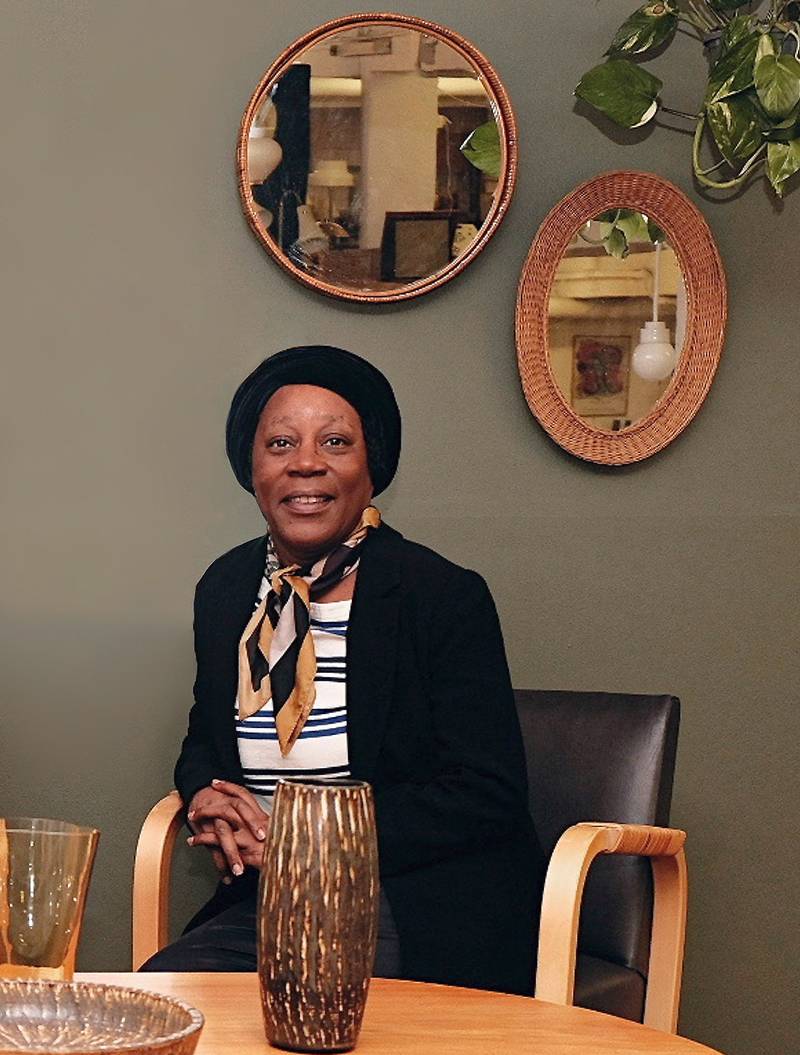

Photo: Nathi Sihlophe
Julian Owusu is a dance artist and dance teacher who has been active in the Finnish Hip hop and dance fields since 2004. Julian’s focus has always been on community building practices. Alongside his work with Hip hop, Julian has also worked as dancer, choreographer and actor at, among others, Zodiak – Centre for New Dance, Jojo – Oulu Dance Centre and the Oulu City Theatre. Julian Owusu worked as Regional Artist for Youth Culture at the Arts Promotion Centre (Taike) in Northern Ostrobothnia and Kainuu regions between 2016 and 2021. Since completing his five-year bid at Taike, Julian has returned to freelance artistic and pedagogic work.
As the applause refuses to end, I am reminded of the interviews, reviews, and think pieces I have devoured in preparation for this keynote speech and, even more so, the interview I have the privilege to conduct the following day. After two years of social distancing, listening to echoing applause in a jam-packed auditorium feels reverberating and thrilling. The room feels electric, and the visual arts students sitting next to me might as well have been at a rock concert.
Sonia Boyce is a pioneer of the British Black Art movement. Her practice stems from the visual arts but has grown in so many directions that categorizing her work into any single art form feels oversimplifying. Then again, that is partly the nature of Black Art: the need and ability to be multiple things and escape definition simultaneously. Sonia and I are from different generations; we work with distinct art forms in different contexts and very different parts of Europe. Despite these differences, we almost immediately find a common language. In our discussion, we define it as the language of blackness. Working as a black man in northern Finland, it is a rare opportunity to have a tête-a-tête with my elders. It can even be hard to recognize my elders. Sonia called it systemic amnesia, how our environments erase our lineages and make us think we are alone.
I want to ask her e v e r y t h i n g.
At the same time, I want to ask her nothing. I merely want to be in discussion with her about anything she feels is relevant. I want to feel my roots grow back and replant into soil physically.
In her keynote speech for the Saastamoinen Foundation, Sonia said she knew while working on her last self-portrait that she simply couldn’t continue doing the same work anymore. I am intrigued by the thought of knowing while working that an art piece might be your last one. Knowing that a particular art form has exhausted its purpose will give space to what needs to come next. I ask about what moved her towards such a change. How could decentralizing herself simultaneously be the contextualizing of herself?
Sonia Boyce: I always thought I was part of something bigger and that I was a useful device for talking about those other things; because one of the ways my work was being received was that it was autobiographic; and the way I saw what I was doing, was me trying to understand history and how we, my family and my wider community, happened to be in the UK. What is our relation to the UK? My father had come from British Guyana in South America, and my mother from Barbados. What was it that brought them to the UK? Of course, the relation between those countries and the UK was empire. So, in trying to figure out myself, I was trying to do some kind of genealogy in the work about how I am here, why did they come here, what brought them here, what’s their relationship to the UK, particularly when in the UK, in my experience of them growing up in the UK, they were foreigners, but then having to really figure out that “well, they are not foreigners because they are part of the British Empire. And what was the British Empire about?” So, even though I was the figure in the work, I was trying to understand why my parents and their generation were being treated the way we were.
I didn’t have to pay myself to be a model, but people wanted to read it just as a kind of autoethnicity - that I am only speaking about who I am and what I am. But actually, I am trying to figure out a specific series of relations, historical relations, to how we were in this space. And I am talking about having lived. Particularly in the 70s, we were living in real abject racism. Living in that context, there was a shift in trying to understand why my parents came here. Because we’re being mistreated and then having to understand the questions of empire and the so-called motherland in relation to the colonies.
I was using myself as a subject because I couldn’t afford to pay anyone else, but also because I felt awkward asking anybody else. At the moment of making the last drawing where I’m the central figure, I realised that I was in a bit of a cul-de-sac where I was only allowed to talk about myself. I’m not allowed to speak of anything else beyond myself. I have to announce who I am. So I am a black female artist, and it should stop there. As a black female artist, I am not allowed to have an opinion (on other subjects and contexts). People asked me, “Why are you doing something about classical music? What is your relation to it?”
As is the case for many marginalized artists, readings of their work are often limited to personal experiences of lived oppression, even though it is just a part of the work, not the whole. Often, in self-referential works, the image of the body is decontextualized from the multiple realities and questions their work seeks to pose. When flattened into personal experiences of racism, the essential functions of the work, like tracing roots, questioning situatedness in time, and dreaming, were rendered impossible. In a sense, Sonia’s work creates a place where she needn’t be didactic, a place that allows ambiguity and opacity, where a collective “we” can exist.
I find ambiguity and opacity in relation to the arts complex. Especially as they often exist in opposition to didactic approaches to art production. As a dancer and Hip-hop head, I often consider art a consequence of social interaction in a community. At the same time, from the perspective of black performance, ambivalence, ambiguity, and opacity feel central to my work. When I share this with Sonia, she responds with a simple question, “Does it have to be a binary?”. It does not; the answer is evident to me. Yet, for some reason, that thinking glitches for me, and I believe for many others too, when it comes down to the question of the actual work we do and not just the thematics of it. I am reminded of the extensive span of her career. When one’s career spans decades, a trajectory of progress (or deterioration) becomes visible in retrospect. The complexities become more graspable when the question shifts from how to when and where when one has time to delve into the questions of relation and possibilities.
Sonia explains how representation can be narrowing. How there sometimes can be fixed ideas of what representations of blackness must be. Much of Sonia’s earlier work could be understood to be works of Black Art, even with little understanding of context. Later in her career, when Sonia worked with different mediums and themes, she was asked how that work was black. How can improvised sound art be considered black? Sonia tells me how vocal improvisation and scatting relate to jazz and how jazz, as an art form, constantly tries to escape categorization.
SB: I showed the work ‘For you, only you’ in a talk at an American university. There was a sizeable African American audience, and I was thrown when an audience member asked, “so how is this black?”. There are almost conventions for what we think representation looks like. For me, in that piece, there is a legacy of sound … and this is why I was trying to underline the relationship between Jazz and concrete music. Representation is not only imagery. We can hear histories in sound, and we can hear messages in sound.
Jazz scat, I believe, and this is probably a lifetime’s work to understand… within the Pentecostal church, there is a thing called getting into the spirit, where one speaks in tongues, where it is not legible, and where it is non-linguistic. And quite often, there is a sense of crying that’s going on in that form. The history of jazz and particularly jazz scat comes not just from the Pentecostal church, which became a site that developed as a form. But it actually comes from the time slaves were working on plantations in what was called Slave Hollers. And that is the birth of jazz and the modern era.
Where there is a code in what’s going on, that as a form is what Henry Louis Gates calls a signifying practice. For me, these codes are still living with us. It might be my fantasy, but I believe that using those codes was how to speak to someone when a system is overseeing you and you need to escape to freedom. How do you communicate when others are watching you and can hear you? What signals might you use to form a plan of escape? This is in the granular of jazz, the granular of the church, and those spaces. Codes that are indecipherable unless you start to know the code. There are different coders, and some are signalling, “ok, we understand, we can hear this, we can see this, we know what that sign means,” and that sign is meant to be decoded. That is its purpose.
We are back with ambiguity and active fugitivity. What I find interesting with fugitivity is direction. It is not a random escape of meanings but intentional displacement into new contexts when work can choose to be didactic to some and opaque to others.
SB: But this is what I mean that it is not necessarily a binary. One of the things for me about free jazz or experimental jazz, or not just jazz but experimentation within the arts, where we can go with it and what it can do, is that there has to be a space of the unknowable for us to feel we can venture into.
I want to ask her about the weight of being the first, but she beats me to it by opening up about the burden of representation.
SB: Part of what I’m hearing in your question is what Kobena Mercer talks about as the burden of representation. Historically, our place in the world has meant that we cannot just think of the I. That’s a cultural legacy and the position we have come into in the modern world. That question of not just the I but the We is part of our essential ingredients. But there is a way in which one can be pressured from within that “I always have to speak with this We or for that We. I am the representative of the We, and We is representative of I.” That toing and froing of having to feel responsible in always those diameters. I completely understand and have lived that constant dance of who has access and who doesn’t have access.
All of those things come from generational experiences of recognizing that, for us to be free, whatever free means, we must think collectively. At the same time, there is the question of the ego. And the ego cannot be ignored. The ego will operate with whoever one is with. That is why I was trying to say play sounds light-hearted. Collaboration and working collectively sound like it’s all good and well, but the question of the ego within that is like the ideal fighting with the driving forces.
Sonia spoke of the significance of play in her keynote speech. Unknown at the time of play, there are specific places where play can take the artist. The significance of actions may be conscious, but we never know the trajectories in which our work may grow. Play asks the fundamental question, “how can we work together?”
Play sounds lighthearted, but it is a highly complex social interaction. Play radically challenges the ego without denying its presence. Play questions and shakes power dynamics. It can bring to light unforeseen possibilities of change and development. Adulthood demands that we disguise anxiety and shame and force suppression. Play, on the other hand, allows all feelings in play to be relativized. In play, one may learn to embrace doing things despite fear. We touch upon the motto of Hip-hop culture being “Peace, love unity and having fun,” thinking about the emancipatory strength in aiming to have fun, despite the harsh realities in which the Hip-hop culture was birthed.
SB: It is a very complex thing. How can we find ways to work together? How can one find an alternative that isn’t transactional in that monetary sense? That somehow, maybe even just momentarily, escapes certain regimes. There is a tiny possibility in play where one can find an alternative to what might seem like a very rigid or oppressive regime that one has to navigate through. So, I understand, trying to imagine being 15 (years old) and feeling scared and wanting a moment in that space where one can feel hope, excitement, and surprise in a good way – and showing one’s skill. Because if one is going to talk about hip-hop, there is an enormous amount of skill. But I also think that these are not gladiatorial but competitive. But competitive, that is fun. There are all of those ingredients in there. Competition has several facets. It’s not just that I need to slay you to be competitive. That is not the only thing that is about competition. Competition can be about the question of raising one higher. And then everybody feels that they are moving forward somehow. And that can be fun. But there is also the question of if someone has done something, and he’s like, “Wow! How did they do that?” That is one of the key things about play. Some things might emerge, like, “Ooh! How did that happen? I have not seen that before. Let me find out how you got there.” It allows the moment of invention.
Thinking of alternatives and dreaming utopias into existence are possibilities that play can create. I ask Sonia what I feel is a complicated question. How does one find relevance and connections to blackness and black art when, for example, in my case, one may live in a place where a black community is, on most days, non-existent in my surroundings? Sonya tells me about her time in Stourbridge.
SB: I did my BA in a small college in the middle of England where there may have been as many as ten black people in the whole town. Three of them were in our school. Growing up in London, a very multi-ethnic and multicultural city, I didn’t have any experience being in a very monocultural place like where I was then. I was thinking about my experience studying at the art school and living in the place. In the first six months, I was very depressed. Every week I went to the library thinking there must be some black artist out there, and I’d look in the art magazines and the library books. At the end of my first year, my tutors hated the work I was doing and were going to throw me off the course. But there is quite a lot of administration if you are going to fail someone and say they have to leave. I think they were not up to doing the administration, so instead, I was monitored throughout my second year, and I had to keep retaking stuff. I was continuously assessed throughout my second year. I had to change my work drastically just to stay on the course.
In my second year, I’m in the library, and there is a photocopied poster, a small handmade image. An exhibition six miles down the road in Wolverhampton is called ‘Black Art an’ done’’. It was like a fractural explosion in my head when I went to that exhibition. It was a group of very young teenagers making work about the experience of being in the UK, and it was raw and direct. Through that exhibition, I discovered that a few months later, a conference would be organized by a group of six-eight students aged eighteen-nineteen. This was the first National Convention of Black Artists in 1982. I went to the conference, and 200 more black artists were sitting in the auditorium, and I was like, how did I not know about these people? I came from London with very romantic ideas about living in the country, and I felt out of kilter to the point of depression, and then coming across 18-year-olds organizing, saying, “Come to this,” and people had come. People from generations before, as well as those still studying. That lit a fuse that we would never have predicted. And now, it is seen as a historical moment. It was a historical moment for us, but we did not necessarily see what that trajectory would be.
But that question of feeling lonely and arriving at some kind of home with others is not easy. I don’t have any balm to offer to lonely people. I’m just saying that I remember being in that lonely place. You reach out but don’t know if anyone is at the other end of the line. But if there is no community, how can you become a part of it? Or, how can you build a community?
Oppressive systems can make us think we are alone even though, in reality, there are multitudes of us living in isolation. A community is not just a physical location. It is also the mass of technologies we have access to. The creation of art itself is a technology of communication. Sometimes communities are found, but sometimes they are built. Sonia tells me of Theaster Gates, who bought buildings in Chicago to provide housing for artists. Community building could be a set of concrete actions. It is also important to understand all the possibilities of what a community can be. Community building can be an artistic practice in and of itself.
SB: I think we need both community and art. I believe deeply that all human societies have had art across the globe – every single one of them. There is always this kind of creative expression, whatever one wants to call it. I don’t think it can be separated from being human and the need to express. Human beings are social beings. We could not sit here on these chairs in this light in this room with all of these things around us without others having done it here. We are never singular. We can’t do it on our own.
The singular genius is a lie. Sonia tells me how she used to be confused about Tarzan. The absurdity of the concept of Tarzan inspired her work From Tarzan to Rambo. Animals raise Tarzan. He has some contact with the indigenous community, though we are never told what that is. He knows how to build a home, and wears a loin cloth, knowing he needs to cover himself up even though he lives with animals. He speaks human language but also communicates with animals. In everything he does, he supersedes all other people, despite never having been trained in any human ways. Tarzan is a superhuman archetype of a singular genius. A singular genius that Sonia claims doesn’t exist. The idea of not needing social structure is illogical. Art and social structure are inextricably linked due to our need to express ourselves and rely on one another. Creating art is creating communities. Social engagement can give space to the creation of art. They go hand in hand.
Unlike Tarzan, human beings need community. That doesn’t mean that social interaction and community building will always be straightforward. On the contrary, multiple complex realities clash when people come together to negotiate for space. When we find a community for the first time, the cause is so great that some realities are difficult to negotiate. Sonia tells me that even though the National Black Art Convention in 1982 was ground-breaking, it was not automatically frictionless cohesion.
SB: It is a difficult thing to talk about. There’s still a lot that I have to unpick. As I said, the context for that conference and the emergence of black art was this wave of trying to grapple with the resistance faced for being black in the UK. This was happening in the Arts and culturally and politically in a wider context. Just like the BLM, when everyone decides we got to change this…
The conference was quite masculinist. There was only one female speaker, who got shouted down while she gave her presentation. Much of the rhetoric was mostly in opposition to the West or Western traditions and Western Art histories. All of these things represented whiteness. I remember being troubled. I can understand how that could be a kind of rallying call. But I remember when I was at the conference feeling troubled. And it has taken me years and years, literally forty years, to recognize. So we are in an art school in Wolverhampton in England. A room full of black artists, and we are saying we are done with white western culture. And I am pretty sure that most people in that room had gone to art school in the UK. And for me, this is a massive contradiction that could not be acknowledged then; still, there are remnants of it. To be part of this is to see yourself as being in something and saying you’re not in it.
Most of my training has been in western art history. That has been my training in the field of art. One can say it is a bad thing. One can say it’s a good thing. I’m just saying it’s a thing. Since then, I have learned a huge amount about myself. I am very aware that I have very particular training. It is a site of many conflicts, but that is where I learned, and I will not deny what I learned there. It is a difficult conversation as a black female artist subject in the context of that conference since things were positioned as a binary. You are either for us or against us.
Their (her children’s) generation can have relationships with several places simultaneously and not be asked to choose. In my generation, it was very much a worldview. I suppose I’m just trying to come back to the question of constantly being asked which side of the fence you sit on but also saying, “do I need a fence?”
In reality, development processes are slow and painful. Years of persistent invisible work eventually yield visible results. I am reminded again of her perspective on time. Our generation has seen the world accelerate. Everything moves faster. There is an urgency to many questions at hand that did not exist before. In relearning the complexities of relationships, we tend to become impatient in working towards immediate, visible results instead of realizing the value of every phase of the work. Making the labour happening in the background visible is a task in itself. Just as oppressive structures make one feel alone, they also make it look untouchable, even when gradually being dismantled from multiple directions. The relentlessness of resistance is vital to its success, even when not all of its parts are visible. Change is slow and is never easy for anyone, yet it is inevitable.
We may not be able to predict significant moments, and even if we recognize them as they occur, predicting the trajectories of their effects on individuals and entire communities is nearly impossible. Once again, retrospection is comfort.
Going back to our conversation with Sonia has had me draw a myriad of links to multiple conversations, lectures, performances, exhibitions, and interviews I have consumed over the past few years. What Fred Moten refers to as the fugitive nature of blackness keeps coming back to me. It has to do with the Black abstract. It is Édouard Glissant’s ‘relation’ and ‘opacity’. It has to do with hip-hop’s realness and authenticity.
It is e v e r y t h i n g.
